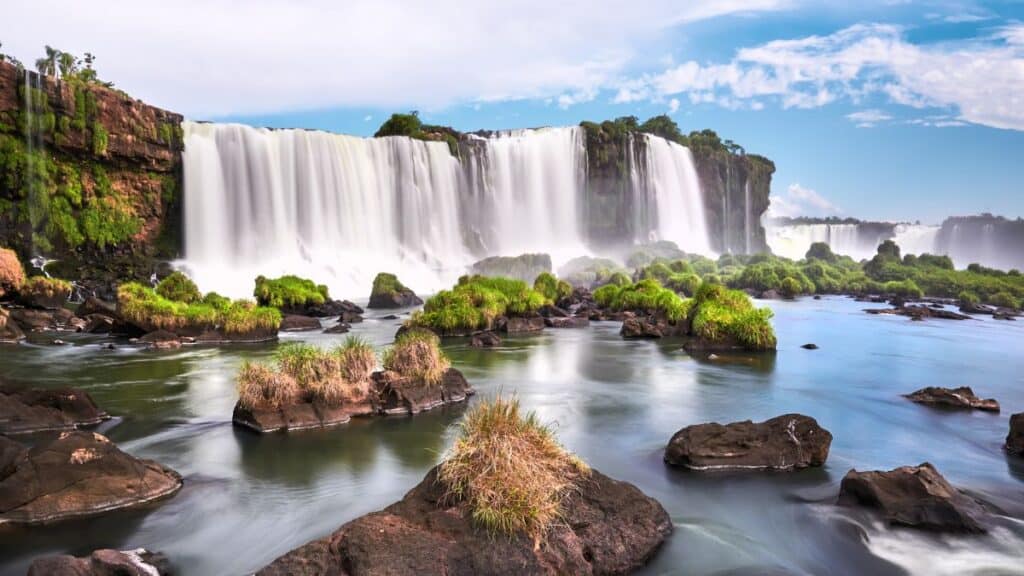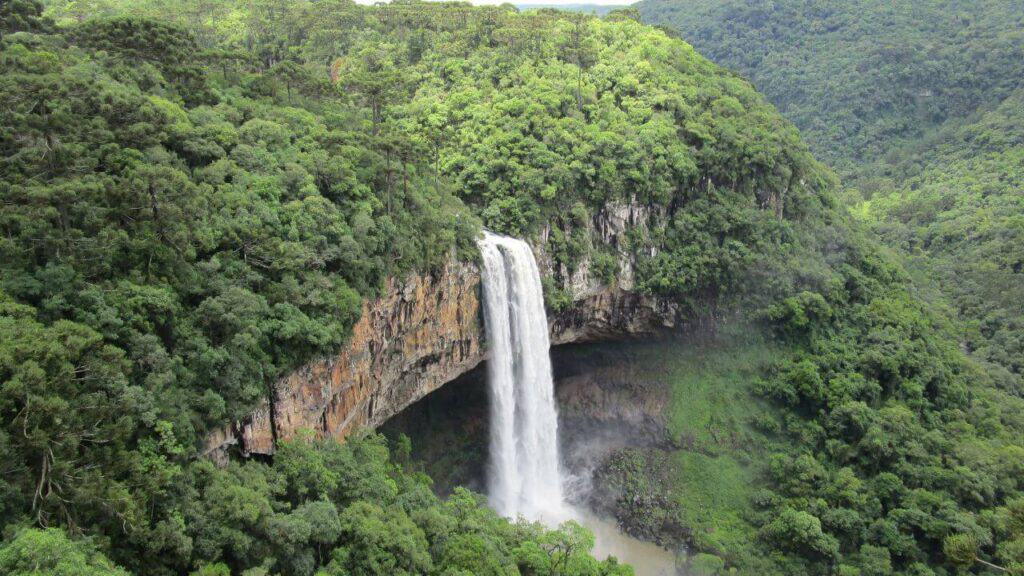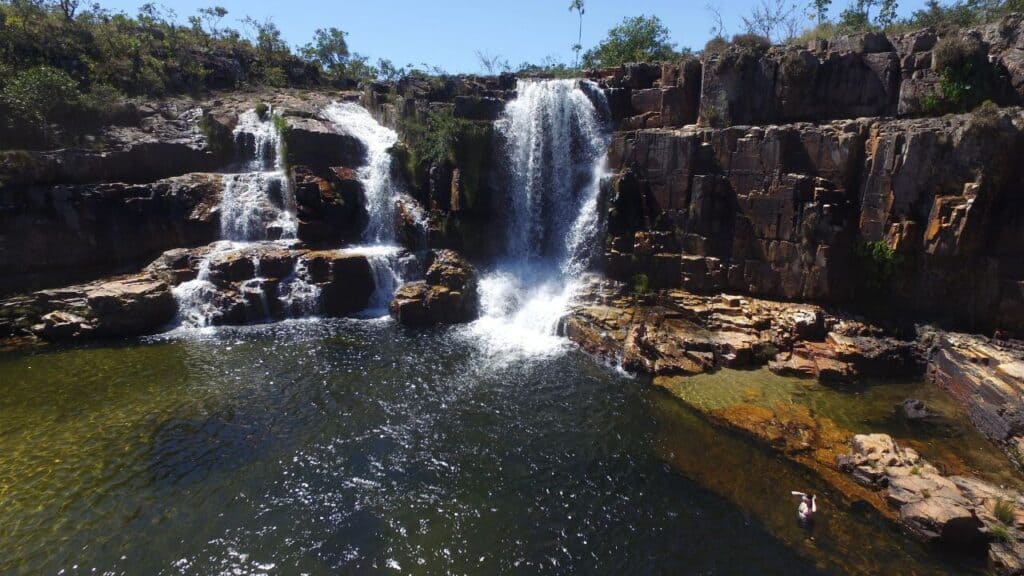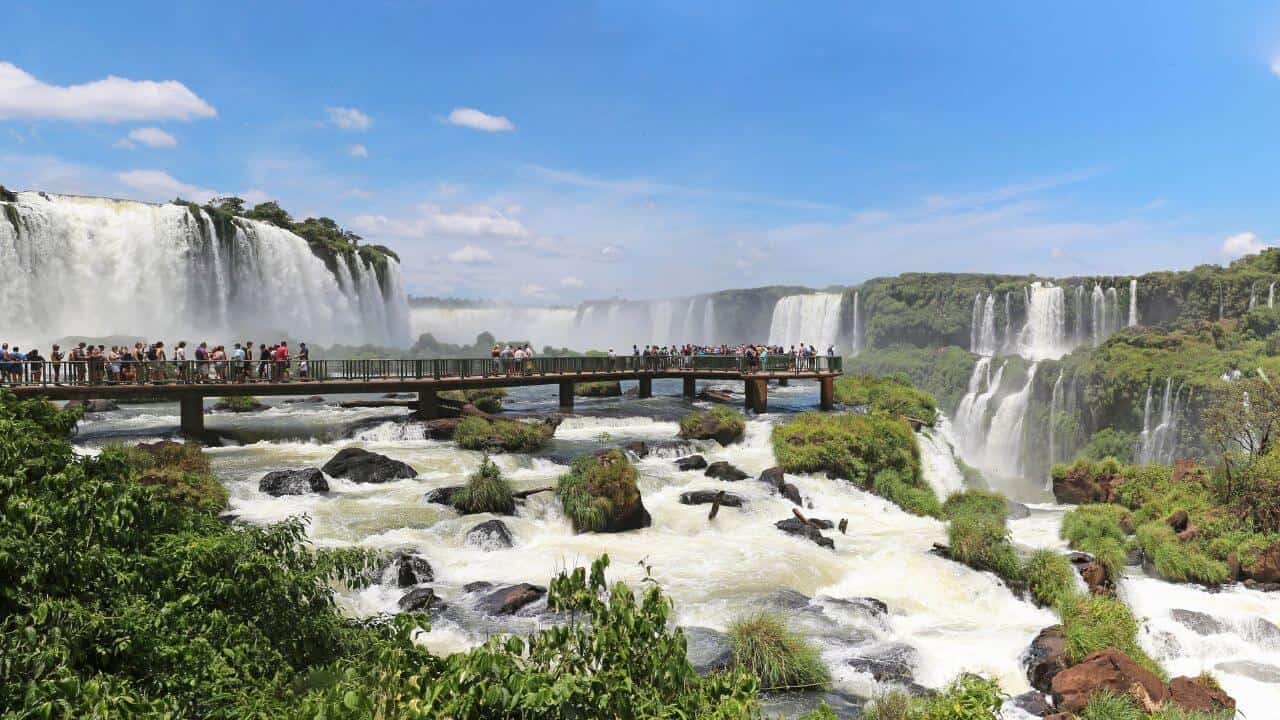Are you planning a trip to see Brazil’s most beautiful waterfalls? Brazil has so many beautiful waterfalls to offer, probably thousands of them. I’ve only seen a handful of them, but I still couldn’t resist making a list of the waterfalls that you should see.
As the largest South American country, Brazil offers many natural wonders, and waterfalls are one of them. They’re so incredible. You can see for yourself, for sure.
Brazil is a fun country to visit, and these waterfalls are one of the ways I hope to convince you to visit this beautiful country. Yes, Brazil is more than Rio and Sao Paulo; it’s forests, waterfalls, and beaches.
26 Most Breathtaking Waterfalls in Brazil
1. Iguazu Falls
With 275 falls, drops, and beautiful cascades, the Iguazu Falls span a nearly two-mile-wide water curtain. It’s the most beautiful waterfall in Brazil, in my opinion. Even when we went three days before Christmas, when it was crazy busy, and the electronic ticketing machines were broken, we had the best time.
Its longest drop, “The Devil’s Throat,” is approximately 269 feet (82 meters) high. You can find these waterfalls in the heart of Iguazu National Park, a UNESCO World Heritage Site.

You can visit here favorably during the Brazilian summer, between November and March. The thundering sounds of the falling waters are something you’ll never forget.
- Location: Border of Brazil and Argentina
- Height: 269 feet (82 meters)
- Number of drops: 275 vertical drops
If you want an aerial view of the Iguazu Falls, this tour typically operates daily from 9 a.m. to 5 p.m.
- Duration: 10 minutes
- Price: Approximately $140 per person
- Details: Offers aerial views of the falls on both the Argentine and Brazilian sides
2. Fumaça Waterfall
Fumaça Waterfall unfurls a dramatic vertical descent from the towering cliffs of Chapada Diamantina. To get there, you can take a hike from Palmeiras or sign up for a 3-day hike from Lençóis.
Best visited during the dry season (May to September), these misty falls require a challenging trek but surround you with panoramic views and plateaus made of sedimentary rocks.
- Location: Chapada Diamantina National Park, Bahia
- Height: 1,115 feet (340 meters)
- Number of drops: Single, making it one of the tallest free-falling waterfalls in Brazil
3. Fumacinha Falls
Fumacinha Falls, nestled within the Chapada Diamantina, is a must-see. To access it, you’ll wind through a scenic trail that allows you to spot capybaras, macaws, and parakeets in the wild. The diverse ecosystem of this amazing fall gives you an experience that almost feels spiritual.
The best time to visit is during the dry season, when the hiking paths are less challenging, and visitors can take a refreshing swim in the crystal-clear pool.
- Location: Chapada Diamantina National Park, Bahia
- Height: 984 feet (300 meters)
- Number of drops: Single, with massive rock walls
4. Buracão Falls
Found within the remote wilderness of Chapada Diamantina, the Buracão Falls is a pristine natural beauty within the park. These spectacular waterfalls move against a backdrop of local plant species like bromeliads and orchids.
More people visit Buracão Falls during the dry season because the hike is more manageable. It’s a truly enchanting experience to discover these falls tumbling into a pan-shaped sinkhole.
- Location: Chapada Diamantina National Park, Bahia
- Height: 380 feet (116 meters)
- Number of drops: Single drop with a rugged, rocky landscape
5. Cachoeira das Almas
Cachoeira das Almas Waterfall is an awe-inspiring display in the Serra da Canastra National Park. Watch out for native trees like candeia and pau-brasil which thrive in the park’s ecosystem. Feel free to explore the network of trails that guide you through the biodiverse setting.
Visit Cachoeira das Almas in the Brazilian winter (June through August) for optimal conditions as you trek to the falls.
- Location: Serra da Canastra National Park
- Height: 1,949 feet (594 meters)
- Number of drops: Multiple, creating a cascade of stunning beauty
6. Santa Barbara Falls
Within Chapada dos Veadeiros, Santa Barbara Falls is a gorgeous natural attraction featuring a bright turquoise pool below the falls. It’s a favorite destination for day trips as it’s easily accessible from nearby towns.
It’s great to visit Santa Barbara Falls in the dry months of May to September. The hiking trail gives you a sneak peek into unique wildlife, such as hummingbirds, toucans, and parrots.
- Location: Chapada dos Veadeiros National Park, Goiás
- Height: 230 feet (70 meters)
- Number of drops: Single, with a turquoise pool at its base
7. Cascata do Caracol

Cascata do Caracol is a miracle of nature, dropping over basalt cliffs framed by a thick canopy. It’s located in Caracol State Park in southern Brazil and is best visited in February.
Visitors can follow a trail through the park for panoramic views of the falls from different viewpoints.
- Location: Caracol State Park, Rio Grande do Sul
- Height: 426 feet (130 meters)
- Number of drops: Single, plunging into a lush green landscape
8. Véu da Noiva
Véu da Noiva, or “Bride’s Veil” in Portuguese, is a beautiful waterfall in the Serra dos Órgãos National Park. The best time to go is during the dry season, between May and September.
Véu da Noiva has an observation point where you can enjoy the best view of the rushing stream. Follow the 1.9-mile (3-kilometer) route from the park headquarters to reach it.
- Location: Serra dos Órgãos National Park, Rio de Janeiro
- Height: 820 feet (250 meters)
- Number of drops: Multiple, resembling a bridal veil
9. Cachoeira do Formiga
The stunning Cachoeira do Formiga comprises a series of waterfalls and pools in the dry landscape of Jalapão.
The best time to go is during the Brazilian winter, and you’ll gain access to the falls by taking a short hike. You’ll want to snap a photo of the blue-green waters over a backdrop of golden sand.
- Location: Jalapão, Tocantins
- Height: N/A
- Number of drops: Multiple, forming crystal-clear pools
10. Cachoeira do Tabuleiro
Cachoeira do Tabuleiro, one of Brazil’s highest waterfalls, is located in the Atlantic Forest. It’s best visited during the winter months of May to September when the weather is cooler, and you avoid the risk of getting caught in the summer rains.
- Location: Conceição do Mato Dentro, Minas Gerais
- Height: 886 feet (270 meters)
- Number of drops: Single, surrounded by rocky cliffs
11. Cachoeira do Itiquira
Cachoeira do Itiquira (or Itiquira Falls) is a stunning waterfall set against the backdrop of Cerrado (tropical savannah) vegetation. The best season to visit the falls is the Brazilian winter, between May and September.
You can easily reach the bottom of the waterfall by walking on a trail. As you walk, breathe in the refreshing mist and feel the waterfall’s power.
- Location: Itiquira Falls, Goiás
- Height: 551 feet (168 meters)
- Number of drops: Single, with a powerful plunge
12. Cachoeira do Mosquito
Cachoeira do Mosquito, a charming destination, is one of the best waterfalls in Lençóis.
A moderate trek leads you to the waterfall, which is best visited in the months June, July, and August. During this time, its clear waters and beautiful environment let you escape from the stress of city life.
- Location: Lençóis, Bahia
- Height: 164 feet (50 meters)
- Number of drops: Multiple, forming cascading pools
13. Cachoeira do Sossego
Cachoeira do Sossego, which translates to “Waterfall of Tranquility,” is immersed in the green oasis of Chapada Diamantina. Visitors can enjoy a hike of medium difficulty through the park.
If you want to experience how serene this place is, visit during the Brazilian winter (May through September) for the best conditions.
- Location: Lençóis, Bahia
- Height: 66 feet (20 meters)
- Number of drops: Multiple, with serene pools
14. Cachoeira do Tororó
Cachoeira do Tororó is a series of waterfalls deep in Chapada Diamantina. Although the pools are shallow and not ideal for swimming, visitors can still enjoy the cool mist from the falls and soak in the atmosphere.
Visitor access to Cachoeira do Tororó is allowed during the dry season (May to September).
- Location: Ibicoara, Bahia
- Height: 59 feet (18 meters)
- Number of drops: Multiple, with turquoise pools
15. Cachoeira do Formoso
Cachoeira do Formoso’s glass-clear pools offer one of the most surreal experiences you can get in Bonito. It’s a popular site among tourists, especially during the Brazillian summer (December through February).
You can go snorkeling or swimming in Cachoeira do Formoso while basking in the colorful landscape. Where else can you cool down in a pool of water lilies and freshwater fish?
- Location: Bonito, Mato Grosso do Sul
- Height: 131 feet (40 meters)
- Number of drops: Multiple, forming natural swimming pools
16. Cachoeira do Mixila
Cachoeira do Mixila treats hikers to mini-paradises like smaller waterfalls and natural swimming pools on the way to the main attraction. The trail’s rocky and slick terrain is quite challenging, but the calming sights you’ll encounter on your path make the journey lighter.
Cachoeira do Mixila was formed beneath huge canyons, and is so hidden that it was only discovered in 2004. You’ll have to swim at least 164 feet (50 meters) at a time to approach the waterfall, so be prepared to leave your belongings at a nearby camp.
- Location: Chapada Diamantina National Park, Bahia
- Height: 262 feet (80 meters)
- Number of drops: Two, under moss-covered shade
17. Cachoeira Loquinhas
Cachoeira Loquinhas is a waterfall in the Atlantic Forest, with greenery right up to its edge. It’s best seen in the summer (December to February), and the magic only grows the longer you stay.
- Location: Alto Paraíso de Goiás, Goiás
- Height: 249 feet (76 meters)
- Number of drops: Multiple, creating a series of picturesque cascades
18. Cachoeira dos Couros

Cachoeira dos Couros is a lesser-known spot in Chapada dos Veadeiros. It’s reachable by a steep path that winds through red canyons and forested foothills.
The best time to visit is during the Brazilian winter (June to August), and the falls’ series of pools and cascades make for a perfect spot for nature lovers.
- Location: Alto Paraíso de Goiás, Goiás
- Height: 393 feet (120 meters)
- Number of drops: Multiple, forming a sequence of stunning cascades
19. Cachoeira Véu de Noiva
Cachoeira Véu de Noiva, not to be confused with a similarly named waterfall, is a serene cascade surrounded by the Atlantic Forest.
The best time to visit is during the Brazilian summer (December to February), and a short hike through the forest reveals this tranquil waterfall.
- Location: Bonito, Pernambuco
- Height: 105 feet (32 meters)
- Number of drops: Multiple, next to a wall of greenery
20. Cachoeira da Pedra Furada
Cachoeira da Pedra Furada is outlined by a unique stone arch. It’s a moderate hike, so if you’re new to outdoor adventures, make sure to prepare. The soothing sound of the waterfall accompanied by leafy terraces makes the effort well worth it.
Visit in the dry season, from May to September, to get the best experience at Cachoeira da Pedra Furada.
- Location: Pirenópolis, Goiás
- Height: N/A
- Number of drops: Single, with a unique stone arch
21. Cachoeira da Marta
Cachoeira da Marta is part of the waterfall network in Carrancas, characterized by its thriving garden.
The best time to explore Cachoeira da Marta is during the Brazilian winter (June to August). These falls are easily accessed via well-marked trails. Among the falls in the region, Cachoeira da Marta stands out for its view of valleys and cliffs, with sunlight gently painting the terrain.
- Location: Carrancas, Minas Gerais
- Number of drops: Multiple, forming cascading pools
22. Cachoeira do Santuário
The peaceful Cachoeira do Santuário offers visitors a serene escape into the Amazon rainforest through a short hike near Presidente Figueiredo. The best time to visit is during Brazilian winter (June to August), when hiking trails are less likely to flood or get muddy. It’s easier to navigate the paths when they’re dry.
- Location: Presidente Figueiredo, Amazonas
- Height: 262 feet (80 meters)
- Number of drops: Multiple, with a serene pool at the base
23. Cachoeira do Rio Preto
Cachoeira do Rio Preto draws visitors in with its natural slide formation. You can glide down the smooth rock face into a cobalt-blue pool below.
The best time to visit is during the Brazilian winter (June to August). Access to Cachoeira do Rio Preto is via a well-maintained trail that leads through a maze of leaves.
- Location: Chapada dos Veadeiros National Park, Goiás
- Height: 394 feet (120 meters)
- Number of drops: Multiple, with a natural slide formation
24. Cachoeira do Garapiá
Cachoeira do Garapiá is a serene waterfall amid the Atlantic Forest in Southern Brazil, just waiting to be reached by a short hike through the woods during Brazilian summer (December to February).
This peaceful spot is perfect for nature lovers looking to relax. The pool at the bottom is surrounded by bright-colored plants and flowers.
- Location: Garopaba, Santa Catarina
- Height: N/A
- Number of drops: Single, with a beautiful pool at the base
25. Cachoeira do Abismo
Cachoeira do Abismo is a charming waterfall in the picturesque Serra do Cipó region, known for its imposing waterfalls, with plentiful flora and fauna. This is a great place to visit from June to August. Access is via a trail that winds through the national park.
- Location: Serra do Cipó, Minas Gerais
- Height: 98 feet (30 meters)
- Number of drops: Multiple, forming an enchanting cascade
26. Cachoeira do Cruzado
Cachoiera do Cruzado is known for its narrow trails that lead through forests and riverbanks. This is one of the most beginner-friendly hikes in the area, taking around 15 minutes. Upon arrival, you’ll be greeted by a thin stream of water flowing through textured foliage.
The ambiance at Cachoeira do Cruzado is very inviting, with restaurants and facilities for visitors. To enter, pay a fee of R$15 ($2.6).
- Location: Carrancas, Minas Gerais
- Height: 66 feet (20 meters)
- Number of drops: Single, plunging into refreshing pools
Frequently Asked Questions – Waterfalls in Brazil
Where Is the Famous Waterfall in Brazil?
The famous UNESCO Heritage Site Iguazu Falls (Foz do Iguaçu) is located on the border of Brazil and Argentina. With 275 falls across nearly 2 miles, they draw over a million visitors yearly.
Why Is Iguazu Falls Famous?
The Iguazu Falls are famous for their immense size, stretching 1.7 miles (2.7 kilometers) in width. They comprise 175 waterfalls, with the most prominent section being the Devil’s Throat, a U-shaped chasm that plunges dramatically into the gorge.
Why Is It Called Iguazu Falls?
The name “Iguazu Falls” comes from the Guarani words “ûasú” (big) and “y” (water), which translate to “big water.” The name reflects the falls’ wide scale, which occupies about two miles.
How Many Waterfalls Are There in Brazil?
Brazil has thousands of waterfalls, thanks to its diverse landscapes like the Amazon Rainforest and Atlantic Forest. The exact count is unknown because water levels change throughout the seasons, and many are in remote, hard-to-reach areas.
Notably, Iguazu Falls on the Brazil-Argentina border is among the most renowned, featuring 275 individual falls.
Conclusion – Waterfalls in Brazil
Brazil is well-known for its breathtaking waterfalls that captivate visitors worldwide. These falls showcase stunning natural beauty and provide exhilarating experiences.
With their powerful flows and lush surroundings, Brazil’s waterfalls offer an unforgettable adventure for enthusiasts and travelers seeking solace in nature.
Your Ultimate Travel Guide & Booking Resources
Skyscanner is my trusted ally for booking flights, guiding me to the perfect travel options while making the journey planning process a breeze with its user-friendly interface and extensive search capabilities.
12Go Asia is my ultimate travel companion in Asia, offering the best budget service platform for seamless booking of trains, buses, ferries, and flights, ensuring every adventure unfolds smoothly and effortlessly.
Booking.com is my ultimate lodging partner. It offers many accommodations worldwide and simplifies my travel experiences with its user-friendly platform and unbeatable deals.
Get Your Guide is my go-to for personalized travel experiences, enriching my journeys with unique tours and activities curated to my interests, making every adventure unforgettable and tailored to my preferences.
SafetyWing is my peace of mind on the go, offering comprehensive travel medical insurance with affordable plans and hassle-free claims, ensuring I can explore the world worry-free, knowing I’m protected wherever I roam.
LifeStraw Go Bottle is my trusted hydration companion for outdoor adventures, filtering water on-the-go to keep me safe and hydrated, ensuring every hike or travel experience is worry-free and enjoyable.
Related Reads:
Founder of Spark Nomad, Radical FIRE, Copywriter
Expertise: Personal finance and travel content. I’m a full-time traveler, and I’ve been to 49 countries and 5 continents.
Education: Bachelor of Economics at Radboud University, Master in Finance at Radboud University, Minor in Economics at Chapman University.
Over 200 articles, essays, and short stories published across the web.
Marjolein Dilven is a journalist and founder of Spark Nomad, a travel platform, and Radical FIRE, a personal finance platform. Marjolein has a finance and economics background with a master’s in Finance. She has quit her job to travel the world, documenting her travels on Spark Nomad to help people plan their travels. Marjolein Dilven has written for publications like MSN, Associated Press, CNBC, Town News syndicate, and more.

